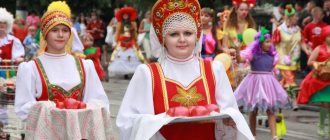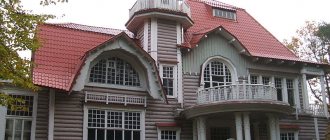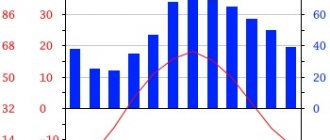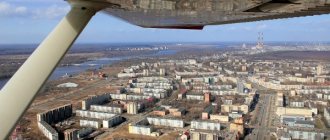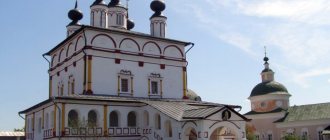Have you often had to open an atlas and look at populated areas? Sometimes you can see unknown small towns and villages on the map. How many people know where Kineshma is? You should definitely find out more about this wonderful city because it is one of the most glorious and oldest cities in Russia with a centuries-old history and... But first things first.
Churches of Kineshma
Kineshma, whose attractions are many temples throughout the city, has ancient churches, most of which were erected in the central part, in contrast to new ones, which were built everywhere.
Kineshma Kremlin (Church of the Ascension)
The temple was built in 1779 with the money of parishioners. This is a seasonal church made of stone in ancient Slavic forms with a separate bell tower. The apse from the East and the vestibule from the West adjoin the 4-pillar, 2-light, 5-domed temple.
The building was transferred to the local history museum in 1929; in 1935, instead of the bell tower, the Chemical-Technological College was erected. After restoration work, the building almost regained its original appearance. Now the church belongs to the Russian Orthodox Church MP. Location – st. Soviet 45.
Ensemble of the Assumption and Trinity Cathedrals
The ensemble includes the Assumption and Trinity Cathedrals, the priest's dwelling and the bell tower and is located on the site of the former fortress. In 1938, the cathedrals were given over to garages, and in 1945 they were opened again. From 1964 to 1991, an art gallery was located in the Trinity Cathedral. The Assumption Cathedral was built in 1745 with donations from parishioners.
In the same way, in 1838, the Trinity Cathedral was erected according to the plan of a student of the St. Petersburg Royal Academy I. E. Efimov. Both buildings are architectural monuments. Now all the buildings have been transferred to the Russian Orthodox Church. Location: st. Soviet 2.
Annunciation Church
The church was built in 1805 near the city burial site. Initially there was a separately built tower with bells, but in the 2nd half of the 19th century. the buildings were united by a large refectory. The temple is an architectural monument of early classicism with baroque elements. The building has a faceted dome; the tower is distinguished by spacious arched openings with double columns.
The most expensive relic located here was an icon depicting Mikhail Malein.
According to legend, Tsar Mikhail Fedorovich gave it to the church. Another valuable thing is an old fold with a cross. Inside it, according to the inscription, are the remains of saints, grains of the sacred tree and the clothes of the Mother of God. The building belongs to the Russian Orthodox Church. Location – st. Ryleevskaya 9.
Church of the Nativity
The building was built in 1754 and is the winter church of the Assumption parish. This is a single-apse quadrangle, there is a refectory, a pillar-shaped hipped bell tower.
The church was rebuilt and closed in the first half of the 20th century. The bell tower was broken, all the interior decoration was lost, only small fragments of 19th-century painting remained on one wall in the refectory. In 1993, the building was transferred to the Russian Orthodox Church and despite the fact that the building is in disrepair, religious services are regularly held here. Location – st. Yuryevskaya 13.
Church of the Transfiguration
Construction of the church was completed in 1694. This brick, 2-story, 5-domed church with a separate bell tower was built instead of a wooden church. There are 5 altars in total: the upper floor of St. the prophet Elijah, the lower one - St. unmercenaries Damian and Cosmas, icons of the Mother of God and Michael, St. Barbarians.
The construction sponsor is L.D. Tyurin. The temple was closed no later than 1930, the domes and bell tower were broken. The building housed a warehouse. In 2000, the church was transferred to the Russian Orthodox Church and restored. Location – st. Yuryevskaya 16.
Chapel on the Kineshma trade square
The chapel was erected in 1744. A massive crucifix is installed inside. This is an 8-sided brick building with a tent-shaped dome, built on the mass grave of city militiamen who died on May 26, 1609 in a battle with the Poles.
Initially, there was only a wooden cross on the mass grave. For more than 300 years, a memorial service was held here on the day of the death of soldiers, they took the oath, and left for battle from this place. Now the building is owned by the Russian Orthodox Church. Location – st. Vichugskaya 92.
Ensemble of the Assumption and Trinity Cathedrals
It is located on the high bank of the Volga, where it blends extremely organically into the surrounding landscape. The ensemble includes two cathedrals (Assumption and Trinity), a bell tower and a priest's house. All structures were built with funds raised by parishioners. First, the Assumption Cathedral in 1745, then the bell tower (in 1798) - it is five-tiered and to this day is considered one of the most picturesque in the Ivanovo region.
The Trinity Cathedral was built later - in 1838. In 1938, both cathedrals were closed, but reopened in 1945. The entire ensemble is an architectural monument, but both cathedrals are active and currently belong to the Russian Orthodox Church.
Location: Sovetskaya street - 2.
Monuments and sculptures
Kineshma, whose attractions are a combination of new buildings and historical monuments, is famous for its many monuments.
House of notary Gorodetsky
The building, made of 1 floor, made of red brick, is an archaeological site with modernist fragments. The northern facade of the building is finished figuratively and turned towards the Volga.
During the period of Soviet power, the mansion housed a children's clinic; now installation work is being carried out here. Location – st. Soviet 36.
Monument to Commander Fyodor Boborykin
The monument was opened on September 22, 2012 and was built by city residents at their own expense in honor of commander Fyodor Boborykin, who led the militia in 1609. He was one of the first to repel the invaders. The authorship belongs to the sculptor Ravil Yusupov. Location – pl. Revolutions.
Temperance society tea room
The building was erected in the 2nd half of the 19th century. This is one of the non-alcoholic cafes that opened at the Holy Cross and Ascension churches. The usual menu is tea with sweets, jam or sandwiches.
The proceeds went to public needs. In 1917, the headquarters of the revolution , the Council of Working People's Deputies, was located in this place, as written on the memorial plaque installed on the left side of the building. After some time, cafes and shopping boutiques were located here. Nowadays there is a hotel complex in the teahouse.
Episodes from the films “The Ulyanov Family” and “Yakov Sverdlov” were filmed against the backdrop of the building.
Location – Volzhsky Blvd. 1a.
Mansion of the manufacturer Mindovsky
The house was built in the 2nd half of the 19th century. by order of Ivan Mindovsky, a major industrialist for his passion. The building went down in history as the “grain commission”. In 1906, unrest arose in the city, and a strike of the working class was organized due to the rise in prices of grain traders due to a bad harvest. On February 15, 1907, a “grain commission” consisting of 18–25 people moved into the house.
They exercised control over sellers, forcing them to sell bread at the set price, without inflating it. After 2 weeks, the commission was dispersed by Cossacks who arrived from Kostroma.
In 1917, the house housed the Council of Workers' and Soldiers' Deputies, and the headquarters of the Red Guard was also located here. Now the building has been transferred to the Regional Tuberculosis Dispensary. Location – st. Soviet 10.
Monument to Alexander Mikhailovich Vasilevsky
The monument was erected on July 31, 1949 in connection with the order of the Supreme Council of the Soviet Union on the erection of busts of double Heroes of the USSR in their places of birth. The author of the sculpture is E.V. Vutetich.
Alexander Vasilevsky was twice awarded the highest military order, and twice he was awarded the title of Hero of the USSR. Location - crossing of the street. Ostrovsky and st. Lenin.
Drama Theater named after A.N. Ostrovsky
It is rightfully considered one of the oldest provincial theaters in Russia. It was founded in 1896 in the city of Kineshma, Kostroma province. Since its foundation, the theater has been named after A. N. Ostrovsky, and was created with the direct participation of members of the playwright’s family.
It was not by chance that the theater received the Ostrovsky name. His estate, Shchelykovo, was located on the territory of the Kineshma district, and the playwright spent several months a year there, taking an active part in the life of the district. The first performance played on the theater stage was based on Ostrovsky's play “Poverty is not a vice.” The premiere took place on December 26, 1897.
Location: Sovetskaya street - 12.
Museums, theaters
The attractions erected in Kineshma at the beginning of the 20th century were made according to the designs of the Moscow office of Julius Burley.
Museum of felt boots
The museum was formed by the Sokolov family and officially opened on June 28, 2012. Now there are more than 150 exhibition items, including outdated wool cutting machines, tools for the production of felt boots, various types of shoes and wool products. The museum also displays the largest pair of felt boots, measuring more than 2 m, and the smallest, measuring 6 mm.
- Location: st. Frunze 6.
- Opening hours: 11:00 – 15:00.
- Closed: Monday.
Sevryugov Estate
The estate was built in 1904 by order of the heirs of the manufacturer P.F. Sevryugov for 2 years. In 1918, the building was nationalized, the eldest son and copyright holder of the estate N.P. Sevryugov rejected the offer of the new government to become a manager and left for France.
In 1930, a factory club was located here, and gradually everything was plundered, the garden was cut down for firewood. In 1971, the building was registered with the state as an architectural monument; in 1986, the estate was transferred to the state protection of the city. Now the estate is in disrepair. Location: st. Socialist 54a.
Tikhomirov's House
The building of 3 floors was erected in the middle of the 19th century. The first owners were the Polenov merchants, who were involved in charity work. In 1890, after a fire, the house was purchased by merchant Ivan Grigorievich Tikhomirov, who restored it.
The 1st floor was turned over to retail boutiques, and people lived on the 2nd and 3rd floors. Now there is an art salon and shops here, the upper floors also remain residential. Location: st. Sovetskaya 1/2.
Kineshma Art and History Museum
The organization of the museum took place in 1919 at the request of the district department of the people's assembly. Here are works of fine art from the collection of N.P. Ruzsky. The museum is also the only organization in the city that deals with inbound tourism.
- Location: st. Frunze 2.
- Opening hours: 9:00 – 17:00.
- Day off: no.
Museum of Military Equipment
The museum was opened in 2013. 14 exhibits are displayed in the open air - samples of military equipment of the 20th century. There is a T-34 tank, a Katyusha artillery mount and armored vehicles from different years. Location: Victory Park.
Drama Theater
On the initiative of the playwright Ostrovsky, who held the positions of justice of the peace and head of the zemstvo assembly for several years, the theater began its work in 1897.
A monument to Ostrovsky was erected near the building. Location: st. Soviet 12.
Trade and industry
On May 29, 1779, according to the decree of the Senate, Kineshma was granted a coat of arms. The coat of arms is made in the form of a shield, in the upper part of which a galley is depicted on a blue field, and in the lower part on a green field there are “two bundles of linen, expressing that this city is conducting a noble trade in them.”
Linen production successfully developed in Kineshma from the beginning of the 18th century, using local raw materials exclusively and targeting foreign markets. By the middle of the 19th century, not a trace remained of the former flourishing linen industry in Kineshma. But on the eve of the development of the cotton, chemical, flour-milling and woodworking industries, the manufacturers Morozovs, Konovalovs, Mindovskys, Razorenovs, Sevryugovs, Skvortsovs, Bakakins, Kokorevs built new enterprises in Kineshma and its surroundings. Trade was carried out widely and briskly, especially during fairs, which were famous throughout the Volga. Fairs in Kineshma were held twice a year. On Tikhonov Day, June 16 (old style), Tikhonovskaya began, another, more significant fair - the Exaltation of the Cross - began on September 14 (old style) and lasted until October. The architecture of the fairground met the requirements of trade. There were three large stone buildings on it, called shopping arcades. They have survived to this day and create a unique architectural appearance of the city center.
The bright and cheerful world of the fair disappeared in the 20th century. It did not disappear immediately, back in the 20s, according to tradition, peasants arrived at the same time with their goods, carousels were built, the raeshnik and Petrushka performed.
Currently, Kineshma is the second largest city in the Ivanovo region. Originating in ancient times as a Meryan settlement, over time it turned into a Slavic fishing settlement-settlement, later into a settlement and, finally, into a city, which in 1616 became the center of the county.
Throughout its centuries-old history, Kineshma has survived the devastating raids of the Kazan Tatars, the invasion of the Poles, two world wars, and numerous fires and epidemics. And yet the city does not seem old and run-down. He keeps up with the times.
Bridges
The examination found that one of the city’s bridges, Kineshemsky, can dance and sway just like the Volgograd Bridge in 2010.
Kineshma Bridge
The bridge was erected in 2003, and it is considered one of the longest in Russia. Its length is 1.63 km. The bridge connects to the Kostroma-Kirov line in the Kostroma region. The attraction was opened by a representative of the State. Duma of the Russian Federation by B. Gryzlov.
- Location: Kineshma-Zavolzhsk road.
- Coordinates: 57.492466, 42.073765.
Nikolsky Bridge
The bridge crosses the river. Kineshemka and connects the residential areas of Logovoye, Sokolniki, Tomna and Zalesye with the main part of the city. The metal structure was built on the model of the European Eiffel bridges of the late 19th century.
The building got its name from the St. Nicholas Church, which is located nearby, but has not survived to this day.
- Location: between Ivanovskaya street and st. Yurievetskaya.
- Coordinates: 57.441353, 42.177590
Kuznetsky Bridge
The bridge is the border of the Volga's navigable space and has been in poor condition since the 60s. It connects the city center with the residential area of Sokolniki and is capable of carrying heavier traffic than the Nikolsky Bridge. Coordinates: 57°26'24″N 42°9'15″E
Attractions in the surrounding area
Church of the Life-Giving Trinity in Šileksha
Coordinates: 57.176846, 42.530285 Address: s. Shileksha How to get there: from Kineshma by private car or bus 46 km (1 hour)
The village of Shileksha appeared in these parts thanks to the construction of the Ferapont Monastery in the 14th-15th centuries. There is a legend that the place was donated by the prince to the Tatar prince Shileksha, who came to the service of Russia. The temple was wooden then.
Later, a stone replacement was built, and the Church of the Life-Giving Trinity appeared nearby in 1800. Money for the construction of the latter was donated by the merchant Fedot Syrenkov.
In 1940, the Trinity Church was closed and a bakery was located in it. After which it was abandoned and destroyed. Today the church is not active.
Cinema "Passage"
The cinema was built at the beginning of the twentieth century. with money from the merchant Tikhomirov and called itself “Modern”. This is a rectangular elongated house, two-level. The main facade of the building, looking at the street. Ryleevskaya, decoratively decorated.
Next to the cash register there is a dressing room, then a hall located on another level. Initially, retail space was located in the lobby, and a restaurant was located on the ground floor. In 1920, the cinema was nationalized and turned into a warehouse.
Most of the interior decorations were also destroyed. Now there is a cultural and entertainment center here. Location: st. Ryleevskaya 4.
Beautiful places in Kineshma - photos
Volzhsky Boulevard
He is rightfully considered the most beautiful. Locals and visitors love to relax here, especially in the summer and in good weather throughout the year. Many famous figures of science and art once walked along Volzhsky Boulevard.
Until the seventeenth century, the boulevard line represented the northern boundary of the city fortification. At that time, the Church of the Transfiguration of the Savior was located here; it was burned by Polish-Lithuanian invaders at the beginning of the 17th century. Until the beginning of the 20th century, the boulevard was wooden. Later, the paths were paved here and a cast iron fence was installed.
The first civil structures made of stone are located here. This is the house of the Nobility, the local government, a mansion belonging to the manufacturer Mindovsky and others.
Recently, the Boy and the Fish fountain and the Lower Embankment were restored. Today this place is a center for cultural leisure. Holidays, theatrical performances, fairs, and competitions are held here. The most striking event taking place here is called the Volzhsky Boulevard Festival.
Monument to Fyodor Boborykin
Bobrykin was a Russian commander and an honorary citizen of the city. Under his command was the local militia during the Time of Troubles. Historians claim that under the leadership of Bobrykin, the people’s militia was for the first time able to withstand the onslaught of impostors.
The memorial structure was opened in September 2012 in honor of the 400th anniversary of the liberation of the capital by the people's militia. Local residents raised money for production.
Red and White shopping arcades
The houses were built in the 19th – early 20th centuries. Red rows are so called because of the color of the bricks. The style is eclectic, with some modernist inclusions and Romanesque decor. Inside, the building is divided into retail spaces with individual entrances. Today there are shops here.
The White Rows were demolished in the mid-twentieth century. Previously they stood in front of the Reds, but now the Molodezhny square is located here. At the end of the twentieth century. the house has been partially restored. Location: st. Ryleevskaya 1.
Sevryugov Estate
This estate was built in Art Nouveau style in 1904, and belonged to local manufacturers. A small park was laid out around the estate. In 1918, after the revolution, the Sevryugov weaving and spinning factory and their mansion were nationalized, and the owner and his family left for France.
Until 1922, servants lived in the estate; later there was a cultural center, clubs, art and music schools. But in the 90s, the institution was closed, and gradually both the estate and the park fell into disrepair. Now the park site is practically a real forest, and the estate is in extremely poor condition. It is not surprising that popular rumors attribute the appearance of ghosts to this abandoned place. A few years ago, a photograph appeared on the Internet in which the silhouette of a girl in a ballgown was guessed.
Location: Socialist street - 48.
Volzhsky Boulevard
Kineshma (attractions exist in every district of the city) offers tourists many places for recreation and walks. Volzhskaya Alley is lined with paving stones and is located above a large cliff, with a river flowing at the foot. From here there is a good view of Kineshma, and a road bridge is visible in the distance.
In the 17th century this place was the northern part of the Kineshma fortress. Until 1920, all fences, roads and sheds were made of wood. Along the alley there are civilian buildings; in ancient times, the Church of the Transfiguration of Spasovo stood here, destroyed in 1609. Coordinates: 57.445820, 42.166437
Story
Kineshma was first noticed as a posad
in 1429[10] In 1504, Ivan III gave it to Prince Fyodor Belsky, who fled to Moscow from Lithuania and married Ivan's niece. Later, Ivan the Terrible gave Kineshma to Ivan Petrovich Shuisky, but after the death of the latter he was returned to Tsar in 1587. In the 16th and 17th centuries, Kineshma was a major fishing center, supplying sturgeon for the royal table. In 1608 it was twice ravaged by the Poles. Throughout its history, Kineshma belonged to different regions of Russia, including Arkhangelgorod Governorate, Yaroslavl Governorate of St. Petersburg Governorate, and Moscow Governorate.
Art Gallery
Located in an old charity house for the poor with the Church of the Blessed Virgin Mary. The building is an architectural monument of the 19th century. The first floor is the Exhibition Hall, which houses works by contemporary masters: paintings, sculptures, installations. The “Art of the 20th Century” hall displays the works of artists who connected their work with Kineshma.
The gallery features works by many artists:
- I. Aivazovsky;
- K. Korovin;
- K. Savitsky;
- L. Turzhansky;
- V. Bychkov;
- L. Chernov - Plessky;
- M. Malyutin.
Works by I. Aivazovsky “Trebizond. 1884" and K. Korovin's "Sevastopol" were restored with donations from guests. Location: st. Bolshaya Komsomolskaya 30.
Kineshma Art and History Museum
It was created on the initiative of the county department of public education in 1919, and was called a scientific and art museum. Today, the museum's exhibitions are located in buildings of three architectural monuments. The local history section is located in the Church of the Ascension of the Lord, the art gallery is in the building of the Mother of God House Church, built in 1908, and in the building of the former House of Contempt of the Poor (built in 1866).
Location: Komsomolskaya street - 30.
Exhibition “Kineshma felt boots”
Here are felt boots of different sizes, listed in the Russian book of records. You can also get acquainted with the step-by-step technology of their manufacture. The entire exhibition occupies 3 rooms; you can order a guided tour.
Kineshmansky felt boots - a landmark known throughout Russia
- Location: st. Frunze 6.
- Opening hours: 10:00-16:00.
- Closed: Monday.
Vichuga is a single-industry town with no real prospects
The number of people living in Vichuga is small - 34,868. Moreover, since 1989 there has been a process of steady decline in the number of city residents, which has reduced the figure by 15,000.
However, city status was received only in 1925, as industry began to develop rapidly, the foundations of which had been laid a century earlier by local merchants, factory owners, and simply enterprising people. Today there are several industrial enterprises operating in Vichuga. Tourists are attracted by the remarkable merchant architecture.
Where to eat
Of all the establishments in the city, the following stand out:
- Coffee shop on Malaya Pokrovskaya. Located on the street. Lenina, 22.
- Cafe Coffee shop Caramel. Located on the street. Lenina, 55.
- Restaurant Russian Izba. Location – Volzhsky Blvd., 2.
- Pivgrad. Address: st. Gogol, 2/67.
- Peaceful Pier. Located on the river on Volzhsky Boulevard.
- Cafe Pyramid. Located on the street. them. M. Gorky, 25.
- Restaurant Volzhskie Zori. Located on Volzhsky Boulevard.
- Cafe Yamato. Address: st. Maxim Gorky, 19.
According to numerous reviews from visitors to the Venice pizzeria, it is not recommended to dine here, as the prices are inflated and do not correspond to the quality.
Shuya - the former weaving capital
Shuya is located near the capital, only 32 km away, but the number of inhabitants is approximately 7 times less. The population density is also one and a half times lower than Ivanovo, amounting to 1,763.98. Archaeological finds in these places indicate the formation of a settlement at the turn of the 10th-11th centuries, but the first reliable mentions date back only to the beginning of the 15th century, when the famous and influential princes Shuisky began to represent their interests here.
Like most other modern cities, Shuya's growth peaked during the Soviet period. By the end of the era in 1989, 72,000 Shuyan lived here compared to 19,600 in 1987. Industry is poorly developed, since new economic rules deprived the town of its status as a textile capital. Today there is only one weaving factory and 7 more relatively large enterprises.
Where to stay
There are 3 main hotels in the city:
- Sadko Hotel. There is a bar, free WI-Fi, 24-hour reception, and a restaurant. The cost of breakfast is 120 rubles, lunch is 200 rubles, dinner is 150 rubles. The average cost of accommodation for 1 person per day is 1200 rubles. Address: st. Shchorsa 1a.
- Peaceful Pier. The hotel is located in a house on the water, 5 min. Walking distance from the city center. Type of breakfast - continental, buffet. There is private parking and a bar. The average daily cost for 1 adult is 2,700 rubles.
- Volga. The hotel is located on the outskirts of the city. There is a fitness center, restaurant, and free Wi-Fi. Cost per day – 900 rubles.
No less popular is the option of renting an apartment, especially if the trip is planned by a group of people:
- Apartment on the street Red Metalist 31. Total area 60 m2, accommodates up to 6 people. Pets are allowed. Cost per day – 3500 rubles.
- Santa Barbara. Address: st. Kasimikhenskaya 1. Pets are allowed. Price per day – 700 rub.
- Apartment on the street Sports 2 . The total area is 36 m2, the number of guests is 2. There is a kitchen and free Wi-Fi. Cost per day – 1500 rubles.
Recommendations
Notes
- ^ a b c d
Law No. 145-OZ - ^ a b
Federal State Statistics Service of Russia (2011).
“All-Russian Population Census 2010. Volume 1" [All-Russian Population Census 2010, vol. 1]. All-Russian Population Census 2010 [All-Russian Population Census 2010]
(in Russian). Federal State Statistics Service. - "26. The size of the permanent population of the Russian Federation by municipalities as of January 1, 2022.” Federal State Statistics Service. Retrieved January 23, 2022.
- ^ a b c
Law No. 145-OZ establishes that the boundaries of administrative districts are identical to the boundaries of municipal districts. Law No. 42-OZ, which defines the boundaries and composition of the Kineshma district, does not include the city of Kineshma in this district. - ^ a b c d
Law No. 124-OZ - "On the calculation of time." Official Internet portal of legal information
(in Russian). June 3, 2011. Retrieved January 19, 2022. - Post office. Information and computing center of OASU RPO. ( Post office
).
Search for postal facilities ( Search for postal facilities
) (in Russian) - Federal State Statistics Service of Russia (May 21, 2004). “The population of Russia, the constituent entities of the Russian Federation as part of federal districts, urban settlements, urban settlements, settlements, settlements of 3 thousand or more people.” [Population of Russia, its federal districts, federal subjects, districts, urban settlements, rural settlements - administrative centers, rural settlements with a population of more than 3000 people] (XLS). All-Russian Population Census of 2002 [All-Russian Population Census of 2002]
(in Russian). - “All-Union Population Census of 1989. Current population of union and autonomous republics, autonomous regions and districts, territories, regions, urban settlements and villages. General information” (in Russian). Kineshma district. Retrieved May 6, 2017.
- "Sister cities." admkineshma.ru
(in Russian). Kineshma. Received 2020-02-05.
Sources
- Ivanovo Regional Duma. Law No. 145-OZ of December 14, 2010 “On the administrative-territorial structure of the Ivanovo region,” as amended. Law No. 2-OZ of February 4, 2015 “On certain areas of legal regulation in the field of names of geographical objects and renaming of geographical objects on the territory of the Ivanovo region.” Came into force 10 days after the day of official publication. Published: “Collection of Legislation of the Ivanovo Region”, No. 50 (519), December 30, 2010 (Ivanovo Regional Duma. Law No. 145-OZ of December 14, 2010 On the administrative-territorial structure of the Ivanovo Region
As amended by the Law of 02/04/2015 No. 2-OZ.
On various issues of legal regulation in the field of naming geographical objects and renaming geographical objects on the territory of the Ivanovo region
. Valid from the date that is 10 days after official publication.). - Legislative Assembly of the Ivanovo region. Law No. 124-OZ of September 29, 2004 “On municipal districts and urban districts,” as amended. Law No. 7-OZ of January 12, 2005 “On Amendments to the Law of the Ivanovo Region” On Municipal Districts and Urban Districts “”. Entered into force on October 1, 2004. Published: “Ivanovskaya Gazeta”, No. 189 (3327), October 1, 2004 (Legislative Assembly of the Ivanovo Region. Law No. 124-OZ of September 29, 2004. On municipal districts and urban districts
in edition of the Law of January 12, 2005 No. 7-OZ.
On amendments to the Law of the Ivanovo region “On municipal districts and urban districts"
. Effective from October 1, 2004).
What to bring from Kineshma as a gift
Souvenirs in the museum of felt boots for every taste, size, age and budget, original felt felt products.
| What to buy | Where to buy | Opening hours |
| Valenki-souvenirs (from 100 rub.) | Museum of felt boots St. Frunze 6 | 10:00-16:00 Tue — Sun. |
| Decorative items of applied art (from 250 rub.) | Art Club St. Soviet 1/2. | 10:00-18:00. |
| Products of folk specialists, paintings. | Club in the Kineshma Art and Historical Museum St. Komsomolskaya 30. | 09:00-17:30 Tue. – Fri. 11:00 – 17:30 Sat. — Sun. 4th Friday – sanitary day. |
| Artistic portrait to order | Private gallery of artist Evgeniy Trofimov St. them. Lenina 27 | 9:00-17:00 Mon. – Fri. 9:00-13:00 Sat. |
According to legend, there is another interesting attraction in Kineshma - an underground city with a railway. There is evidence that during the war, important things were brought here through secret routes for storage.
Author: Sadovskaya Alena
Article design: Mila Friedan
The most significant cities of the Ivanovo region by population
Although there are only 17 cities in the region, they account for the bulk of the population, accounting for 82.33%, according to 2022 information. The region also has 13 urban-type settlements and 31 workers’ settlements. The region cannot boast of millions of people. The largest entity is the capital Ivanovo, where 406,113 people live. The rest of the top ten offer even more modest figures: none of them reach the 100,000 mark.
The list of the most densely populated entities of the subject includes:
- Ivanovo - 406 113.
- Kineshma - 83,871.
- Shuya - 58,723.
- Vichuga - 34,868.
- Furmanov - 34,309.
- Teykovo - 32,791.
- Kokhma - 30,316.
- Springs - 24,662.
- Privolzhsk - 15,824.
- Yuzha - 12,834.
